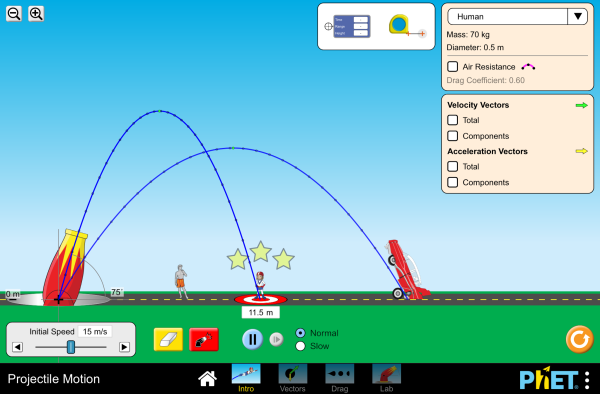2011-2012 Particle Motion Definition and Calculus
Using the Fundamental Theorem of Calculus, — This will give 1.346, so, combining 3346 91. A particle moves along the x-axis so that at any time t 0, its acceleration is given by a(r) = velocity of the particle is 2 at time t = 1, then the velocity Of the particle at time t = 2 is (A) 0.462 (B) 1.609 (C) 2555 (D) 2.886 (E) 3.346 In(l + 21. AP Calculus AB Particle Motion Worksheet In #1-5, answer the following questions for each position function s(t) in meters where t is in seconds if a particle is moving along the x-axis. The position of particle Pis given by x P(t) = ln(t22t+ 10) when 0 t8, so its velocity is given by x0 P(t) = 2t 2 t22t+10 = 2(t 1) (t 1)2+9: (21) The denominator of this fraction is never negative, being 9larger than a square. Therefore, the sign of the derivative (which is velocity) is determined by the sign of its numerator.
The Ap Calculus Ab exam will cover Particle Motion. 2011-2012 Particle Motion Definition and Calculus The position of a particle (in inches) moving along the x -axis after t seconds have elapsed is given by the following equation: s = f (t) = t4 – 2 t3 – 6 t2 + 9 t (a) Calculate the velocity of the particle at time t.
The position of a particle (in inches) moving along the x-axis after t seconds have elapsed is given by the following equation:
s = f(t) = t4 – 2t3 – 6t2 + 9t
(a) Calculate the velocity of the particle at time t.
(b) Compute the particle’s velocity at t = 1, 2, and 4 seconds.
(c) When is the particle at rest?

(d) When is the particle moving in the forward (positive) direction?
(e) Calculate total distance traveled by the particle (i.e., forwards and backwards) after t = 5 seconds.
(f) Calculate the acceleration of the particle after 4 seconds.
(g) When is the speed of the particle constant?
Solution:
(a) The velocity is the derivative of position, so the velocity is v(t) = 4t3 – 6t2 – 12t + 9.
(b) Simply plug into the velocity equation to get: v(1) = –5 in/sec, v(2) = –7 in/sec, v(4) = 121 in/sec.
(c) If you graph the velocity function on your calculator, you see that it appears to pass through x = –1.5. Use synthetic division to ensure that this is true and to factor the equation. You will get the following:
(t – 1/2)(4t2 – 12t + 6)
Now, use the quadratic formula to solve the quadratic part, and you’ll see that the velocity equals zero (in other words, is stopped) when t = –1.5, 0.6339745962, 2.366025404. Even though you can round to the third decimal place, you need to use these values for the remainder of the problem.
(d) If you plug in values into the velocity equation between the x-intercepts above, you will get positive values on the intervals (–1.5, 0.6339) and (2.366, ∞). Note that it doesn’t quite make sense to have negative time, so (0, 0.6339) is just as acceptable, and perhaps more so, for the first interval. We do this because positive velocity implies forward movement.
(e) First, substitute the “turn points” you found in part (c) into the position equation. When the velocity equals zero in this problem, the particle is stopping because it is turning to go the other way. You find thats(0.6339) = 2.946152423, s(2.366) = –7.446152423, and s(5) = 270. Note that the negative x-intercept is ignored because you cannot move back in time.
These numbers represent how far the particle is from the origin at specific times. So, the particle moves 2.9 inches to the right of the origin, then moves 7.44 inches left of it, and finally ends up 270 inches to the right of it. By the time t = 2.366 seconds, the particle has traveled to the right 2.9 inches, back 2.9 inches to the origin, then left 7.4 more inches. It then moves 7.4 inches back to the origin and ends up 270 more inches to the right of it. The final answer is 290.785 inches.
(f) The acceleration is the derivative of velocity, so a(t) = v’(t) = 12t2 – 12t – 12. The acceleration at t = 4 seconds is a(4) = 132 in/sec2.
(g) Set the acceleration equal to zero and solve using the quadratic equation: t = –0.618 sec or 1.618 sec.
The video may take a few seconds to load.Having trouble Viewing Video content? Some browsers do not support this version – Try a different browser.
Showing top 8 worksheets in the category - Rectilinear Motion With Answers.
Some of the worksheets displayed are Ap calculus work rectilinear motion, Ap calculus curriculum module motion, Kinetics of particles force mass acceleration method, Linear motion graphs, 8 rectilinear motion, Kuta software, Ap calculus review position velocity and acceleration, Topic 3 kinematics displacement velocity acceleration.

Once you find your worksheet, click on pop-out icon or print icon to worksheet to print or download. Worksheet will open in a new window. You can & download or print using the browser document reader options.
Mario Particle Motion Ap Calculus Notes

AP Calculus Worksheet: Rectilinear Motion
AP Calculus Curriculum Module: Motion
Mario Particle Motion Ap Calculus 2018 Problems
Kinetics of Particles: Force-Mass-Acceleration method
Mario Particle Motion Ap Calculus Problems
PMO1.2: LINEAR MOTION: GRAPHS
8 Rectilinear Motion
Kuta Software
